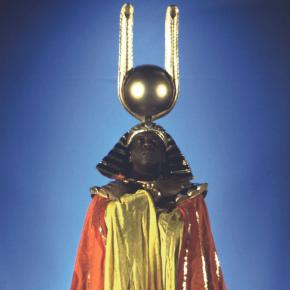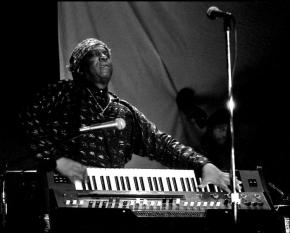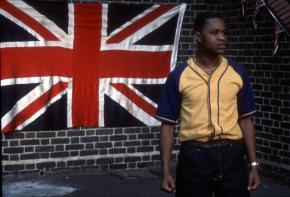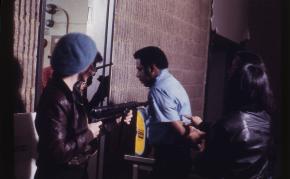Are we real?
The present programme, as its title suggests, rests upon two key elements: the experience of the North-American cinema of Blaxploitation, and the trans-national (and trans-planetary) artistic movement known as Afrofuturism, which rewrote the histories of the African diaspora and slavery through new cosmological paradigms, mythologies, and techno-futurisms.
From a queer perspective, their analysis through the prism of the intersection between different categories of power, such as race, gender, and sexuality is certainly of great interest, as is realizing that both have influenced, and still influence, several queer “black” visual and musical artistic expressions, in the USA and the UK as well as in Jamaica, such as soul, hip hop, rap, bouncing, voguing… Our intention is to begin a conversation upon various visual and musical utopias stemming from the African diasporas in English-speaking countries and, subsequently, their dissemination across the world.
In the final minutes of Space is the Place, the 1974 film starring jazz musician Sun Ra, there is a scene that may help summarize the common thread between all the films in this programme, as well as the complementary musical events, performances, and installations. While Sun Ra is performing live, two “white” police officers shoot a young “black” man, and leave him dead on stage. Sun Ra and his Arkestra continue to play, and their sound waves resurrect the young man and transport him into Space, to the place where the musician is attempting to transport all American “blacks”. Of an extremely upsetting and current realism, the teenager lying in a pool of his own blood becomes transfigured, literally lifted off into a symbolic space outside time and history, a space for rebirth and utopian justice.
 Space is the Place
Space is the Place  Sun Ra in 'Space is the Place'
Sun Ra in 'Space is the Place'
Even though Sun Ra’s figure is difficult to summarize, the aspect that moved us to create this programme is his iconographic break with contemporary models, both on the jazz musical scene and “black” activism. His performance of “black” masculinity, as well as his idea of musical resistance against the racist violence of the post-slavery society, does indeed seem to come from another world. In drag as a pharaoh, Egyptian god, or alien, he reminded the “black” youth that he was not real. Are you for real? No-one among them could be, because all Afro-American history is an unreal, monstrous sci-fi horror; from which only the freedom of sound could redeem them and lead them to a different reality. It isn’t hard to understand how “black” activists at the time would react with perplexity, if not outright hostility to such a stance.
We were, however, also especially interested in reframing Sun Ra’s utopia in the groove of Blaxploitation cinema. It would indeed be hard to imagine a film such as Space is the Place, were it not for the previous two or three extremely fertile years, during which the genre had blossomed and offered, among hundreds of titles, Sweet Sweetback Badassss Song, such an innovative film in its visual and narrative languages – as well as a pioneering example of “black” characters claiming their own subjectivity, while eschewing stereotypes such as the villain or the slave; and being given a chance to escape “white” oppression and have a future after the credits roll.
 Young Soul Rebels
Young Soul Rebels
The phenomenon of Blaxploitation is, for those who work with the concept of “queer”, as attractive as it is problematic. A marginal cinema, which attempts to boost the visibility of categories which are oppressed and excluded from mainstream US film representation (one could recall that this was the very American cinema whose early history featured The Birth of a Nation, by D. W. Griffith, a film in which the Ku Klux Klan is fully and openly celebrated), but at the same time, sought quick box office results – and found them through the use of an African-American nationalist affirmation sustained and strengthened by sexist and homophobic notes. However, this also was the genre which made Pam Grier popular as the “queen of Blaxploitation”, through characters such asCoffy and Foxy Brown, which in their extraordinary strength in confronting sexism, became symbols of reference in “black” feminist discourses.
 Last Angel of History
Last Angel of History
Isaac Julien, whose films feature in the present programme, also examined Blaxploitation in his Badassss Cinema: A Bold Look at 70s Blaxploitation Cinema, and in particular its relevance in representing the black community on the big screen – while also questioning its sexist and homophobic stance. On the other hand, in The Darker Side of Black, Julien explores popular “black” culture in the USA; Jamaica, and the United Kingdom, using rap and reggae as examples, and considering how their affirmation occurred through the ritualization of machismo, misogyny, homophobia, and the glorification of weapons. If, on the one hand, certain movements are strongly characterized by racism and homophobia, we find some respite in those who aspired to create dissident and queer alternatives. We return thus to Paris is Burning, the film which gave voguing, a movement born within the gay and trans “black” and “latino” communities of New York, international popularity. By reclaiming dancehalls as queer political spaces, voguing gave rise to an utopia, far from sexual and racial discrimination, and still inspires current artistic productions.
This is why we suggest a celebration of our programme not just through film, but also through music and dance, and why we decided to invite artists and performers, such as Vaginal Davis and Liad Hussein Katorowicz, whose work explores the relation between racism, sexuality, and diaspora in queer experiences; Berries, for a night of homo pop and queer rap music; as well as House of Melody, who will lead workshops and perform in a voguing show on the closing night.
 Born in Flames
Born in Flames
The programme also includes A person is more important than anything else…, by Hank Willis Thomas, a multi-channel installation comprising a flux of sound and images traversed by James Baldwin, and his concerns upon issues of race, gender, class, and sexuality.
We also seize the opportunity to single out the launch of the book In a Qu*A*re Time and Place. Post-Slavery Temporalities, Blaxploitation, and SunRa’s Afrofuturism between Intersectionality and Heterogeneity, by Tim Stüttgen, a dense and passionate book to which we owe a great debt of inspiration.